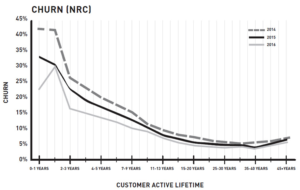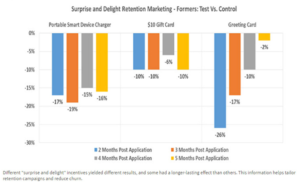By: Xavier van Leeuwe, Matthijs van de Peppel, and Matt Lindsay
Director of Marketing and Data, Manager of the Data Intelligence and Customer Relationship Management Team, and President
NRC Media and Mather Economics
In the relationships between a company and its customers, customers want and deserve appreciation. This is especially when you are in a business with recurring fees like the news industry.
Many subscribers read the newspaper for 20, 30, or 40 years, paying hundreds of euros or dollars, and they never hear anything. They don’t get a discount or a present, and, at the same time, there are huge promotions to acquire new subscribers. This frustrates them and feels dishonest.
And you know what? They are absolutely right.
However, if we wanted to reward all these loyal customers with, say, a mere €50, it could instantly bankrupt the company. And that discount wouldn’t even be satisfying for those customers if it wasn’t as large as the discount for new subscribers.
At the same time, we need those discounts to get new customers to sign up, because in the future, they will be the ones paying full price and keeping the business going. From price elasticity analysis and testing, we know that the influx of new subscribers will dramatically decrease if we stop giving discounts.
It feels like a Catch-22. There is no solution, because you need the money from your relationships, and you don’t have the money to give anything back.
At NRC, we started to think about ways to give little presents to our subscribers. We did a lot of qualitative research in so-called d.school sessions. It turned out our subscribers were not necessarily looking for a discount. Most of them are quite wealthy and don’t really care about that. It was about showing attention and gratitude for their business, and money is never the best way to show gratitude. Subscribers told us they just wanted sincere attention, and if we gave a present, it had to do with the newspaper.
The first thing we did was just starting to say “thank you” every once in a while. We developed an automated e-mail campaign that sends a message from our editor-in-chief on subscription anniversaries. So once in a while, readers receive an e-mail that is just a short message to thank them for their trust in our company, sometimes with a free NRC e-book attached.
What we also did, in cooperation with the head of the service department Heiko Imelman, was empower our customer service agents to send personal, handwritten notes to customers. We sometimes sent these to people who had a problem with the newspaper itself, like a delivery issue. But we also sent them to subscribers who faced challenges in their personal life (like stopping the newspaper because they lost their job).
These things are quite simple. They don’t require big investments of money or time, but they do make a huge difference for our relationships. For the first time in history, our department started to receive fan mail from subscribers — letters with phrases like, “My sincere compliments for the customer-friendly service. Great how you handled my holiday break!”
When you take it one step further, you really start investing in relationships and implementing services that cost money but build relationships. That’s what we did with the holiday service.
We got rid of the administrative fee to pause the delivery, made sure that customers kept their digital access when they are on holiday (even if they weren’t paying at that moment), and started to promote the pause service in the newspaper. The number of holiday breaks increased by 23%, which meant less revenue and less audit bureau circulation for the company. But this is what it takes to build long-term relationships.
All these things will help to improve customer satisfaction and decrease churn. However, there are two other things that are more important than delighting your customers:
- A good product: When your product is bad, your customers won’t be happy, whatever you do in communication or service.
- The brilliant basics: Don’t start with fancy stuff if the basics are not brilliant yet. If delivery is failing, fix that before you start sending postcards.
If your product is good and the basics are settled, delighting customers with excellent service, sincere attention, and little gifts will result in an improvement in satisfaction metrics, like the Net Promoter Score. On top of that, it pays off in terms of revenue and number of relationships by decreasing churn. At NRC, churn rates decreased to an all-time low for customers of all ages and in all tenure segments.

At Newsday, similar improvements were made to increase the loyalty of readers by investing in the relationship. The objective was to revive a relationship under strain without suffering huge costs.
With the help of Matt Lindsay, Newsday researched the effects of different affordable gifts on churn prevention. The test was run on subscribers with the highest propensity for stopping, as identified by the prediction model. We measured the effects of three kinds of presents on the relationship: a portable smart device charger, a US$10 dollar gift card, and a thank you greeting card.
The greeting card had the greatest short-term effect in retention with the quickest decline in effectiveness while the charger and the US$10 gift card had more permanent effects on retention. Calculating the cost of the incentives and further segmentation of the audience, an optimal strategy for each customer group was found.
In a follow-up test, the surprise-and-delight retention marketing campaigns were tested on subscribers whose churn risk increased from one month to the next. In these cases, the reduction in churn was much greater than the effect on high-churn customers who did not show increasing churn risk.

As always in marketing, it is all about timing. It pays to react when the increased churn risk occurs.
For full article, click here.

